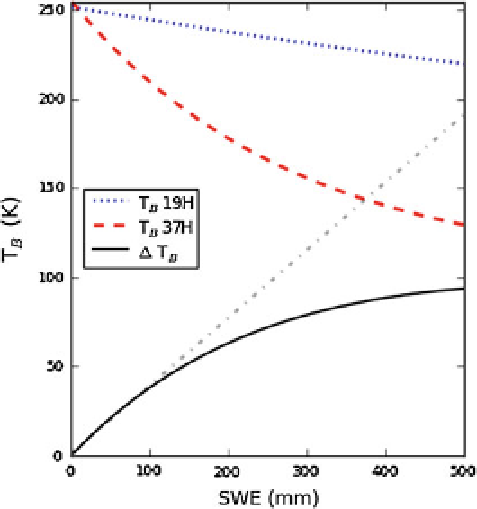Geoscience Reference
In-Depth Information
Fig. 1 Simulated brightness temperature for a homogeneous snowpack as a function of snow water
equivalent (SWE) at the Advanced Microwave Scanning Radiometer for Earth Observing System (AMSR-
E) channels near 19 and 37 GHz horizontal polarisation. Snowpack properties are averages from Cold Land
Processes Experiment (CLPX) snowpits where depth was \120 cm. Density of 170 kg m
-3
, grain size of
0.53 mm, snow temperature -4.6 C and ground temperature -1.5 C. The upper dashed lines show the
brightness temperature at 19H and 37H as labelled in the legend (centre left), the solid line is the difference
in brightness temperature between the two (see Eq. (
1
)), offset by 3 K to ensure that the value is zero when
no snow is present. The straight dash-dotted line is the best fit to the first 100 mm of SWE
in Fig.
1
as a flattening of the solid line). The limiting value of this saturation depends on
snow properties and was reported by Foster et al. (
2005
) to be 0.8 m depth.
In reality, the saturation level depends on the snow properties and on the definition of
saturation. For the snow properties shown in Fig.
1
, saturation could be determined as the
point at which the SWE inverted from the brightness temperature difference using a linear
fit diverges by more than 10 % away from the true value. In this case, this occurs at a SWE
of 143 mm, equivalent to a depth of 79.4 cm which matches well with the value provided
by Foster et al. (
2005
).
An alternative definition of saturation accepts that a more complicated function may be
used to map observed brightness temperature difference to SWE. Under this definition,
saturation is the point at which the signal is no longer sufficiently sensitive to SWE. This
can be determined as the point at which error in inverted SWE, D SWE, exceeds some
acceptable value D SWE
a
. The sensitivity of brightness temperature difference DT
B
¼
T
B
19H
T
B
37H to SWE is
oDT
B
oSWE
where the partial derivatives indicate that DT
B
is not
only a function of SWE. If the brightness temperature difference observation has a pre-
cision D
ð
DT
B
;
obs
Þ
, then the SWE at which saturation occurs is defined from:
SWE
1
[ D SWE
a
oDT
B
oSWE
DDT
B
;
obs
ð
2
Þ
Therefore, the saturation value depends on the acceptable uncertainty in SWE, the
precision of the observing system and the properties and uncertainties associated with the




